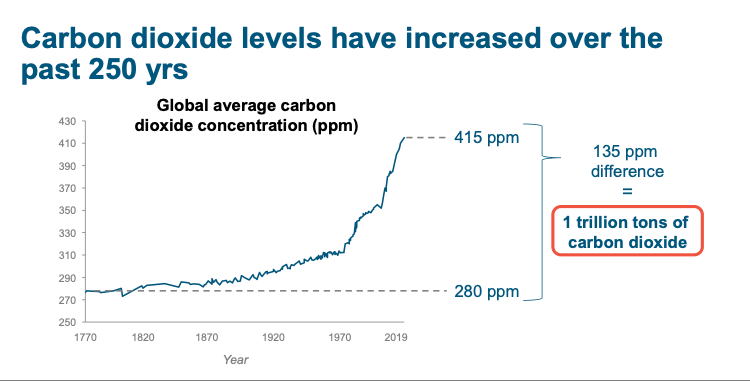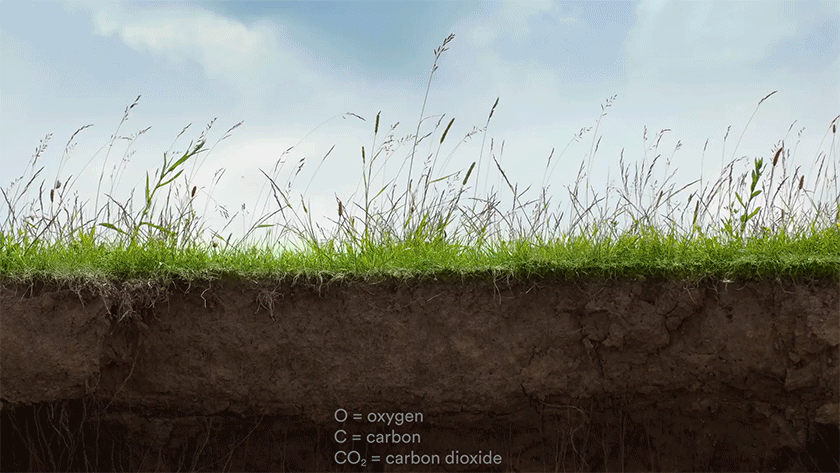Indigo Agriculture has unveiled its latest initiative, and it’s the most ambitious yet; the Boston-based agtech startup wants to reverse climate change.
Indigo first came onto the scene with a microbe-treated seed product and soon surprised observers by launching a range of other services including a grain marketplace, a logistics platform, and a data-based agronomy service backed by TellusLabs, the satellite imagery analytics startup it acquired last year.
With 10,000 farmers in its network and over $600 million in venture capital funding, the startup has the resources to think big and deploy innovative business models, and today’s is no exception.
Today, the company launches the Terraton Initiative, with the aim of sequestering one trillion tons of carbon dioxide from the atmosphere by incentivizing farmers to adopt regenerative agriculture practices.
Regenerative agriculture, which has been dubbed “beyond sustainable,” seeks to improve the state of agricultural soils through a self-nourishing ecological system. Regenerative practices have the potential to sequester carbon dioxide from the atmosphere and store it, not only halting the industry’s impact on the environment but reversing it.
Indigo says that if farmers can increase the level of carbon in their soils by an average of 0.5% globally, they can reverse the one trillion ton increase in atmospheric carbon since the Industrial Revolution, according to data captured by the National Oceanic and Atmospheric Administration earlier this year.
“This is something I’ve been thinking about for more than a year,” David Perry, Indigo CEO tells AFN (and his LinkedIn posts over several months confirm this). “And the truth is that it’s the most helpful thing regarding climate change; all other discussions are around slowing the damage we’re doing, which is necessary but not very inspiring. The ability to sequester carbon in the soil is the only thing that can take place at the right scale to solve a one trillion ton problem, and it’s executable today; it does not depend on moonshot technology, and it’s reasonably affordable. It just comes down to us; if as a society we make a decision, we can do this.”

“Through the process of photosynthesis, agricultural plants have the ability to economically pull more carbon dioxide out of the atmosphere than any other technology,” wrote Geoffrey von Maltzahn, PhD, Indigo’s chief innovation officer, and co-founder in a press release.
How Will it Work?
To sequester carbon at these levels, Indigo plans to deploy its army of agronomists to help farmers convert to regenerative agriculture, following, at least to start with, the five below practices:
Cover cropping: plant crops that protect and enrich the soil, known as cover crops. Perry says these can be sold through Indigo Marketplace that currently lists 14 different crop types. “It will be fascinating to see how that changes if this gets widespread adoption; we could get a lot more production of small grains away from typical corn, soy, and wheat,” says Perry.
No-till: tilling, or plowing the soil as it’s also known, can reduce the soil’s carbon-storing potential. Undisturbed forest soils, for example, contain an average of three times the level of soil organic carbon found in farmland soils of the same type, according to Indigo’s press release.
Crop rotation: some farmers plant the same few crops year after year for economic reasons. This can deplete valuable nutrients in the soil and its potential to store carbon. Planting different crops each year can reduce soil erosion, increase soil fertility, and crop yields.
Reducing the use of chemical and synthetic fertilizers and pesticides: overuse of these products also damages the soil. Biological alternatives, such as Indigo’s microbe-treated seed, helps reduce their use but can also be beneficial for the soil.
Incorporating livestock: Contrary to popular belief, raising animals on pastureland can sequester carbon and be beneficial for local ecosystems. Indigo states that the conversion of pastureland to cropland production has reduced soil organic carbon by a factor of 2-4 times in arid and humid climates.
While Indigo’s client base is made up of crop farmers, livestock farmers are welcome to join the initiative too, according to Perry.
Incentivizing Carbon Sequestration
Indigo will then measure how much carbon a farm has sequestered using soil sampling and lab analyses, as well as other data collection methods such as satellite imagery.
“It helps a lot that we’ve been building data collection tools through our Indigo Research Partners program, and we can use satellites for a lot, certainly verifying that farmers are doing what say they are, but we’re also hoping to use that imagery to measure or estimate soil carbon levels.”
On this measurement, Indigo is collaborating with a non-profit consortium focused on building healthy soils — Ecosystem Services Market Consortium. It is also in discussions with Dr. Keith Paustian, the creator of COMET-Farm, a voluntary carbon reporting tool for farmers, quantifying how much carbon they sequester from the atmosphere by implementing conservation practices on their land. Paustian recently won the Groundbreaker Prize at the FoodShot Global challenge.
Through a new marketplace called Indigo Carbon, the startup will facilitate an incentive payment per ton of captured carbon by food companies wanting to sell carbon-negative products. The credentials of the crops grown will be traceable through Indigo’s Transport service.
Indigo will guarantee farmers who join Indigo Carbon in the first year a price of $15 per ton of carbon, but ultimately this price will be set by supply and demand.
Other organizations and individuals, such as non-profits seeking to maximize the impact of their sustainability investments, businesses wanting to be carbon neutral, and investors and insurance companies trying to hedge climate risks can participate in the market too.
“We’re having conversations with these other groups that want to offset climate risk and their own carbon footprint’ they’re early but promising and we’ll pursue all of them,” says Perry.
Indigo estimates that farmers could earn between $30 to $60 per acre per year from Indigo Carbon, roughly doubling their proftability, according to Perry.

What Do the Experts Think?
“This is an exciting, potentially game-changing initiative,” Renee Vassilos, an agricultural economist, tells AFN. “There are two areas that will be interesting to watch. The first is the willingness to pay for these carbon credits: of the food companies looking to offer a carbon neutral product and the businesses looking to be carbon neutral. This is the critical, other half of the market Indigo is creating. To date, this has been a constraint in driving change at scale. The second is around the measuring of carbon sequestration over time. The Indigo team highlights the production practices that are required for a regenerative farming system. It is, in fact, this whole system shift that is needed to deliver the significant positive impact they are targeting. That said, there is no other agriculture company as audacious as the Indigo team. I hope they can start to move this vitally important needle at scale!”
An early customer of the initiative is Anheuser-Busch, the alcoholic drinks maker, which inked a deal with Indigo earlier this year to purchase 2.2 million bushels of sustainable rice, at a premium cost. In this instance, the carbon credit is baked into the cost of the product.
Dr. Richard Teague, a professor & associate resident director of research in the department of ecosystem science and management at Texas A&M also highlighted the importance of a full systems approach to make this initiative a success:
“The key here is the adoption of all of those practices together, but current ag doesn’t promote practices that are regenerative, and if you mix up practices and only do some of them, for instance, continue to apply chemicals, it will fail,” he tells AFN.
The approach taken to convert to those practices will also be key — Teague suggested following in the footsteps of trailblazers like Gabe Brown who told AFN last year that there’s “no silver bullet” when going regenerative. It could also take several years before farmers feel the benefits.
“Some of these practices are quite easy, such as introducing cover crops or diversified crop rotations, but fully transitioning the farm to a more diversified operation: that’s going to take many years,” says Benedikt Bösel, chair of Soil Alliance and managing director of Schlossgut Alt Madlitz, an ecological farm and forestry in East Germany where he’s implementing different forms of regenerative agriculture, transitioning the farm from previously conventional farming methods.
“It’s also worth bearing in mind that farmers might experience a dip in yield and revenues in the first few years as they adjust their practices. So motivation is key: am I willing to start a new journey towards turning the farm operation more regenerative? And if yes, am I willing to bear that risk and at the same time essentially re-learn everything?”
There are also question marks around applicability for farm subsidies that are baked into farmers’ business models.
The Terraton Experiment
As part of the overall initiative, Indigo is partnering with the Soil Health Institute, The Rodale Institute, and a network of grower partners, to quantify farming practices that maximize soil carbon sequestration and understand the impact of these practices on farm profitability and crop nutrition. “The results of this experiment will form the blueprint for maximizing soil carbon sequestration,” reads a release, and Indigo says it will make the data from this study available to other research institutions.
“There hasn’t been a lot of focus on measure soil carbon as a predictor for the measurement of soil health,” Perry tells AFN. “And because of that lack of focus, there hasn’t been a lot of rigor; that’s why we feel we have to do this study and we’re going to see differences between climates, soil types, management practices, and so on and we need to gather the data rigorously.”
“We’re in a unique and advantaged position with regard to gathering that data and certifying it in that we already have relationships with farmers – and have our agronomists on the ground,” he adds.
“I’m encouraged by Indigo’s intention to initiate large scale monitoring and tracking of changes over time in soil carbon and other key soil attributes – and particularly to make that data open source,” Dr. Paustian wrote to AFN after receiving his award at FoodShot Global awards ceremony at Stone Barns yesterday.
“Those data are essential to help track system performance and whether the carbon sequestering (and GHG emission reducing) activities are meeting objectives and the data will also be invaluable in helping the scientific community better understand and predict impacts of implementing soil conservation practices on soil C sequestration/GHG reductions.”
“The main quibble I would have is with the total potential. Most assessments suggest that gains on the order of 2-5 billion tonnes per year of CO2 removal via ag soils (for example here), over few decades, is a reasonable estimate of ‘technical potential’ at present. So at the upper level that gets us in the area of 100-200 billion tonnes of CO2 removals. That is a huge amount(!) and would be a game-changing contribution to climate mitigation, requiring a fundamental restructuring of our agricultural landscapes worldwide. But that massive potential achievement would be well short of a ‘terraton’ (1,000 billion tons). Hence I would caution against raising expectations unrealistically and perhaps giving a false impression that this is a ‘silver bullet’ that can solve the climate crisis. It could help immensely, but there are no silver bullets! We need to do a multitude of actions collectively to address the problem – ag has a key role but is not a single solution.”
Indigo will also be looking to work with startups on innovations that can help towards this goal, and participating farmers will be in the running to win an award in Indigo’s Carbon Cup.




